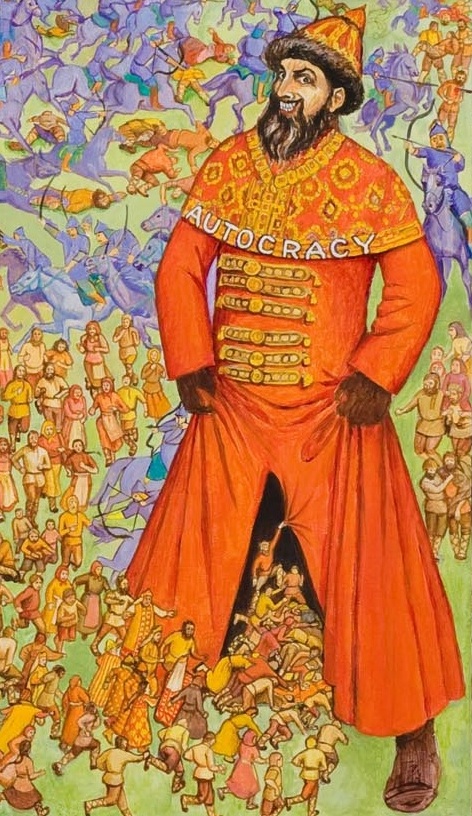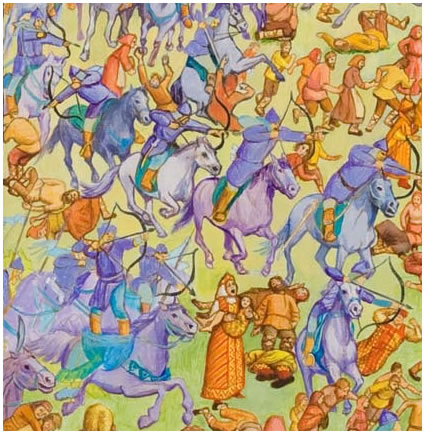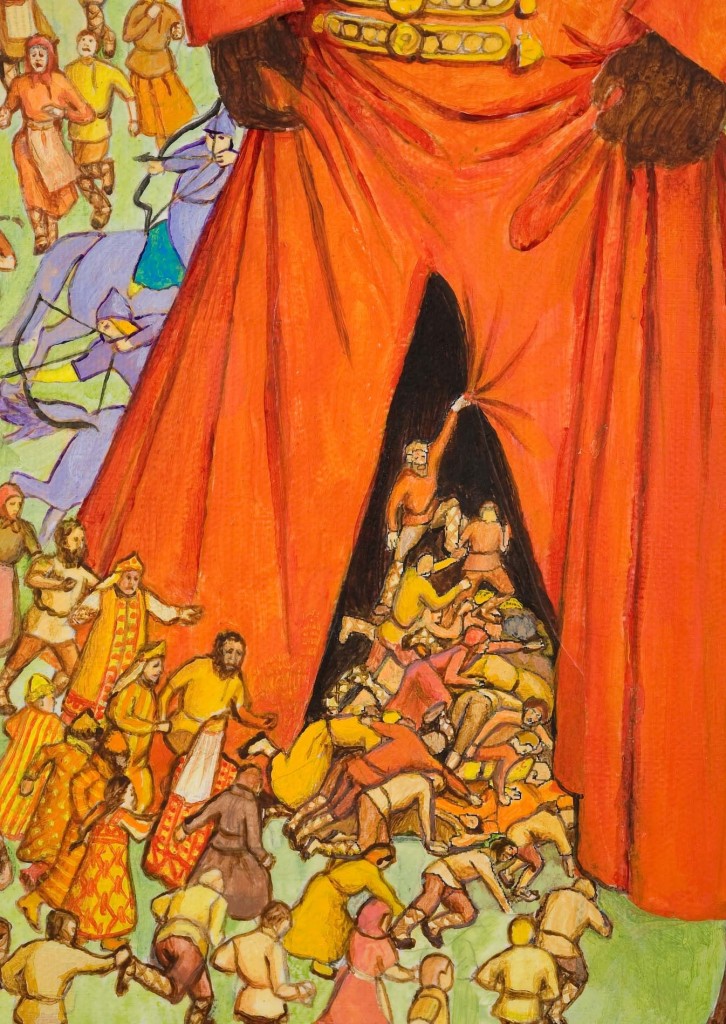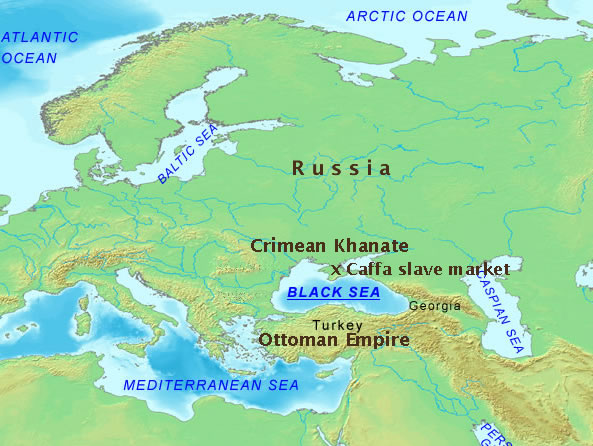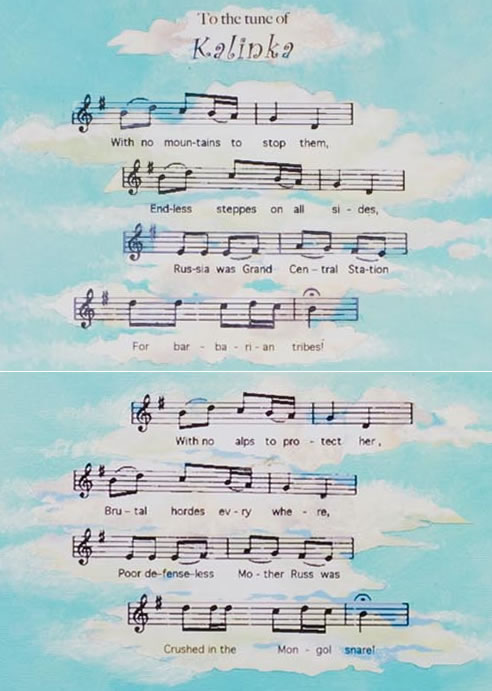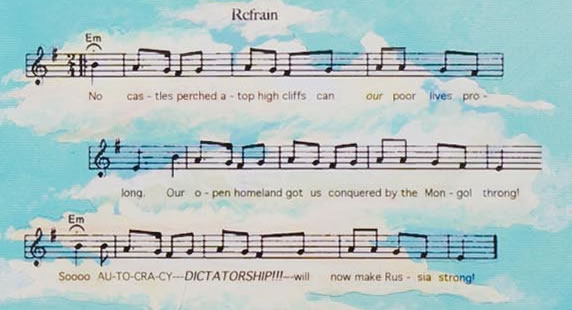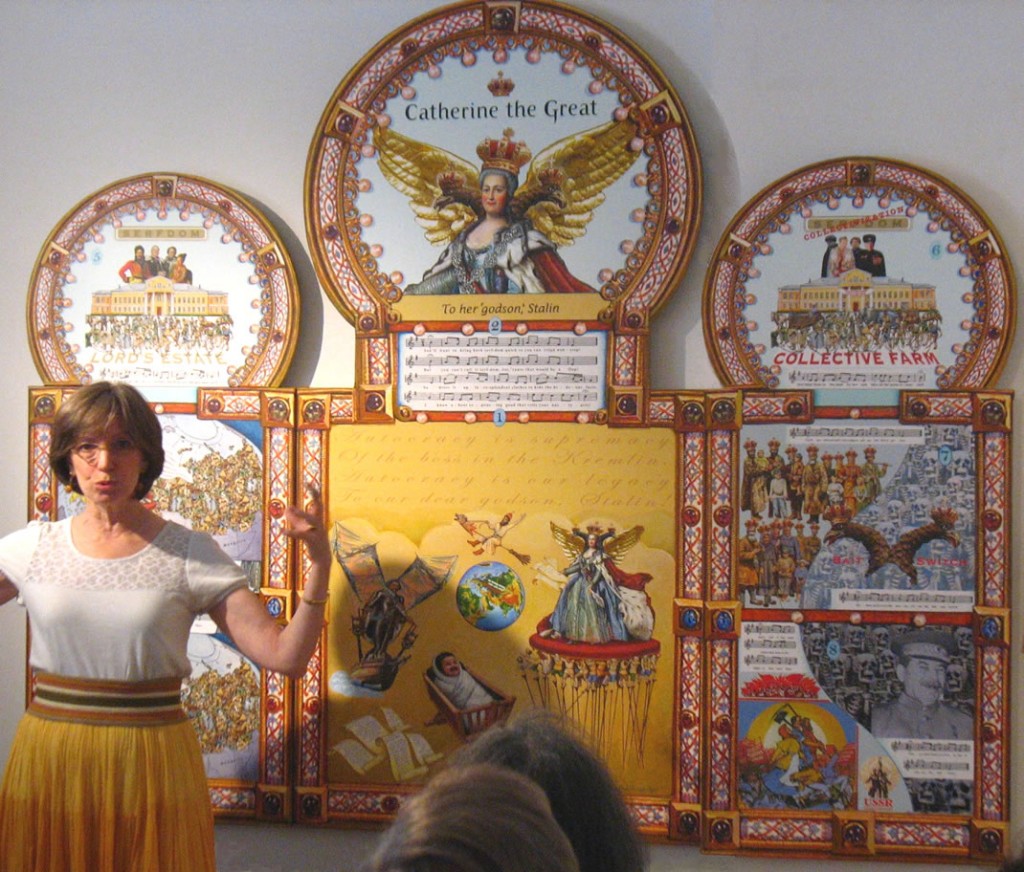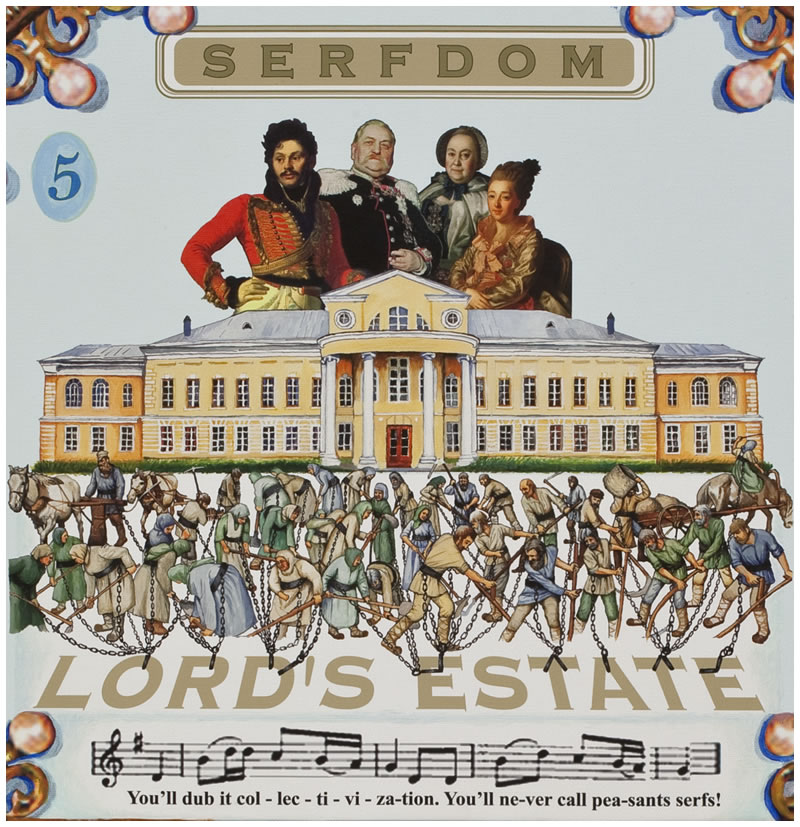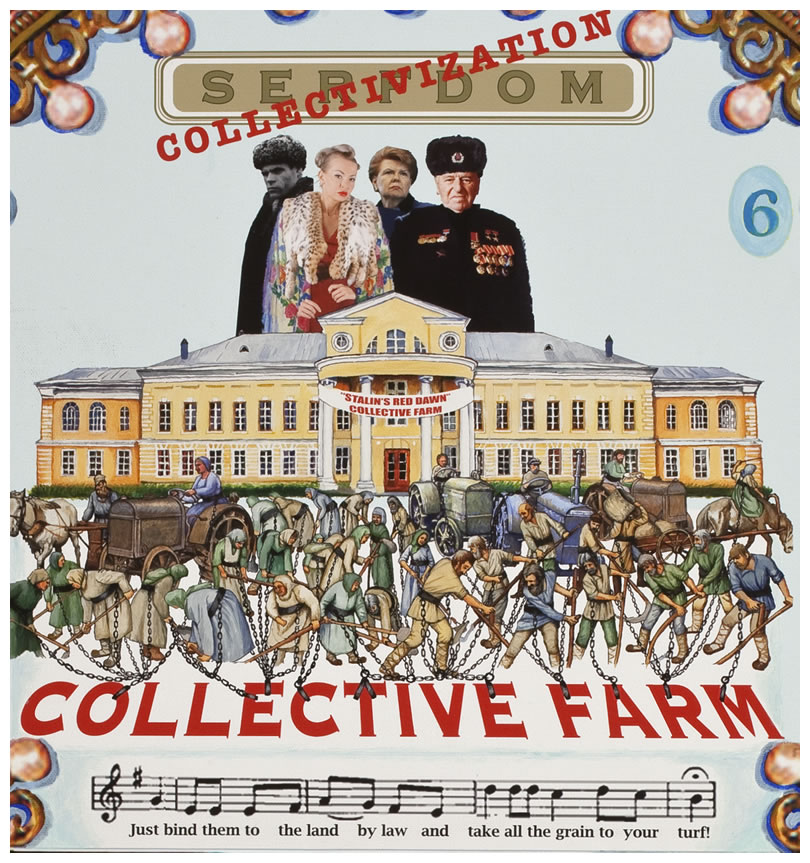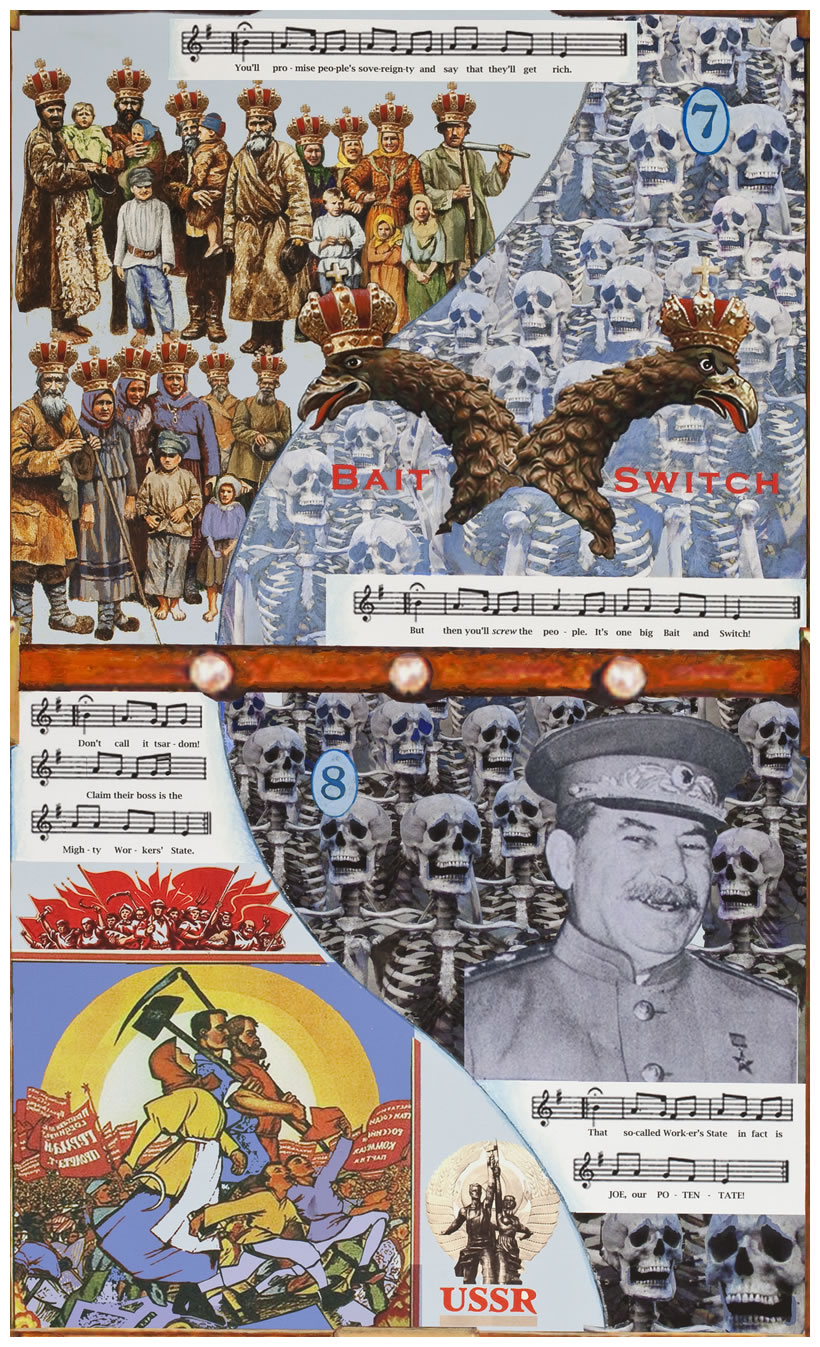“Home Security At Any Crazy Price”
Long before 9/11, I had written early drafts of lyrics for what would become one of my mixed media artworks about Russia, Home Security at Any Crazy Price.
At the time I thought my theme was very specific to Russian history, a bit too esoteric for most Americans. It was about Tsars building their dictatorship by taking advantage of popular fears from centuries of brutal enemy onslaughts. I planned to paint Ivan the Terrible and Peter the Great singing to each other:
Darling Ivan, our Founder (Darling Peter, my Scion),
How fortunate it has been
That the Russian populace is deeply traumatized
‘Cause barbarian onslaughts lay waste their paradise.
Now folks want home security at any crazy price. (Continued below image)
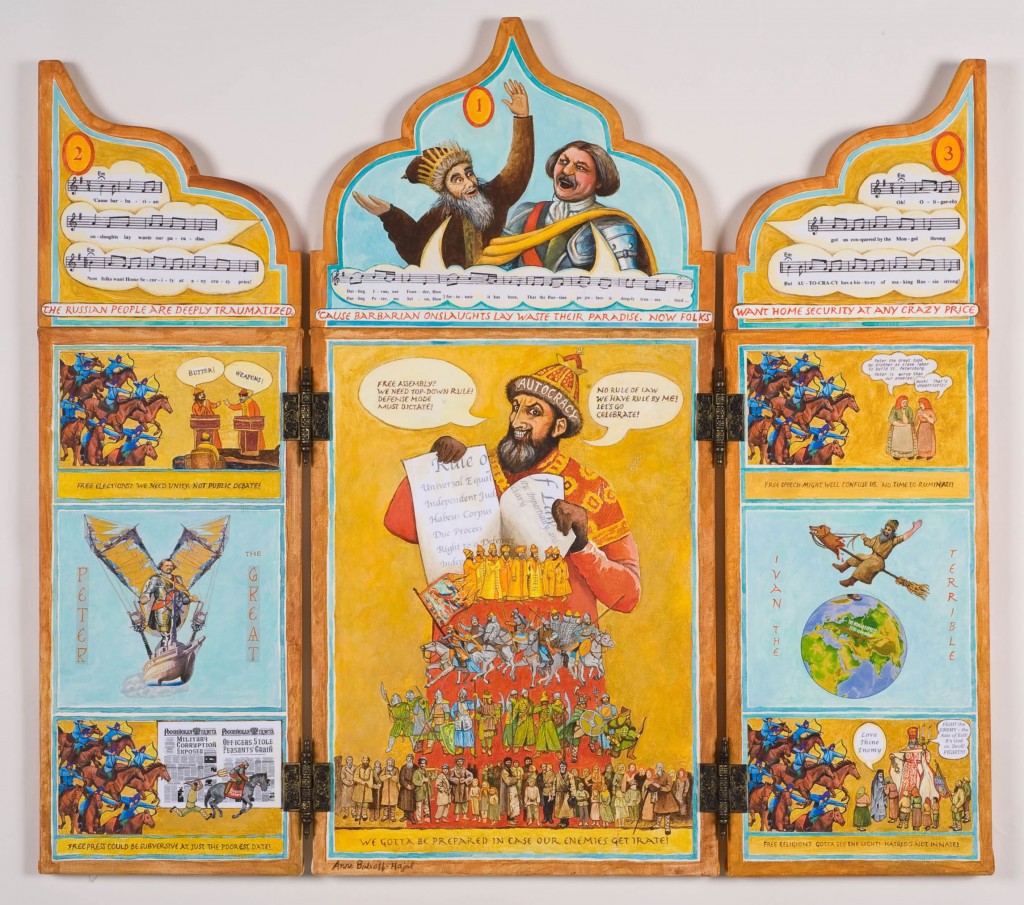
“Home Security At Any Crazy Price,” by Anne Bobroff-Hajal . 36″ x 40″ . Acrylic and digital images on canvas and board . 2009
Then came 9/11. Many Americans’ response – their sudden willingness to give up personal freedoms if the government could only keep them safe – revealed that a similar dynamic to Russia’s can play out wherever people come under attack and feel profoundly threatened.
All at once, my planned artwork seemed absolutely current and relevant to the US today. Continued below image
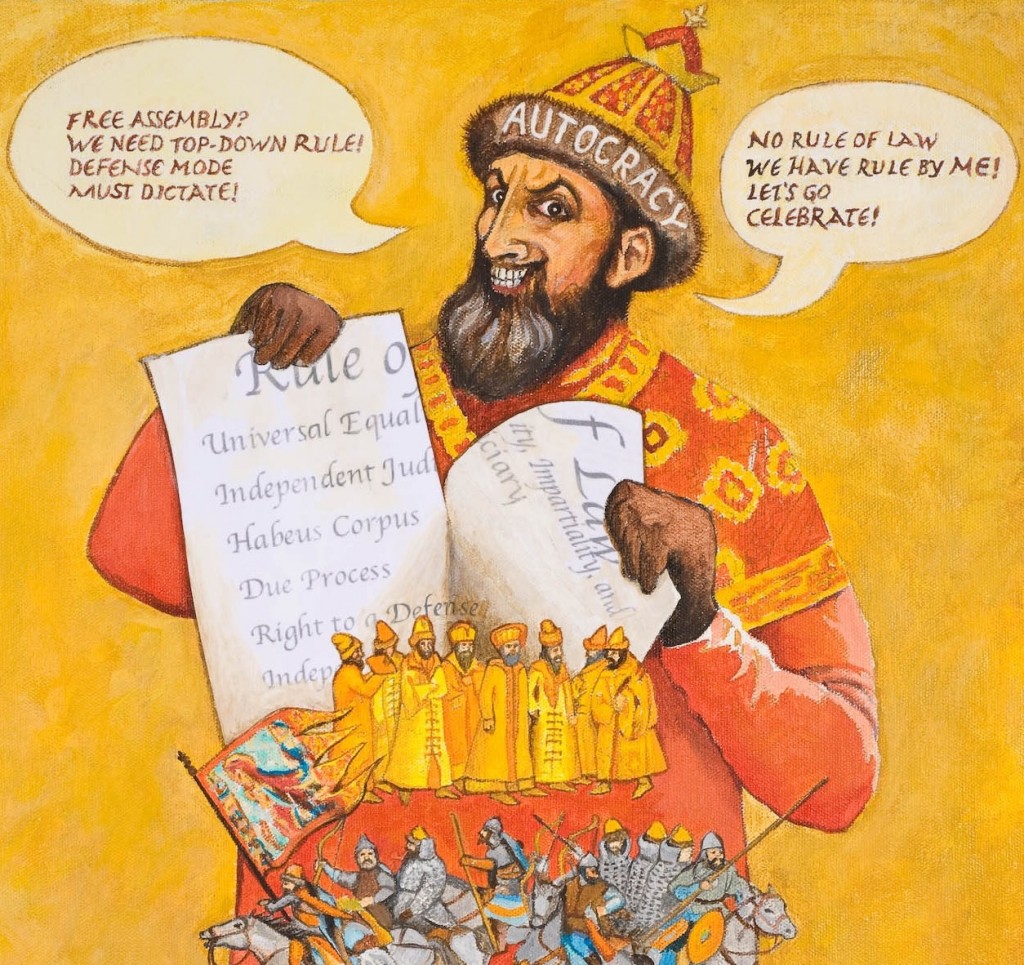
Detail of center panel of “Home Security At Any Crazy Price,” by Anne Bobroff-Hajal
Americans have relaxed a bit since 2001, having experienced no further attacks on the scale of 9/11. We’re no longer as ready to trade our civil liberties for a strong government to protect us from seemingly imminent terror.
But what if…
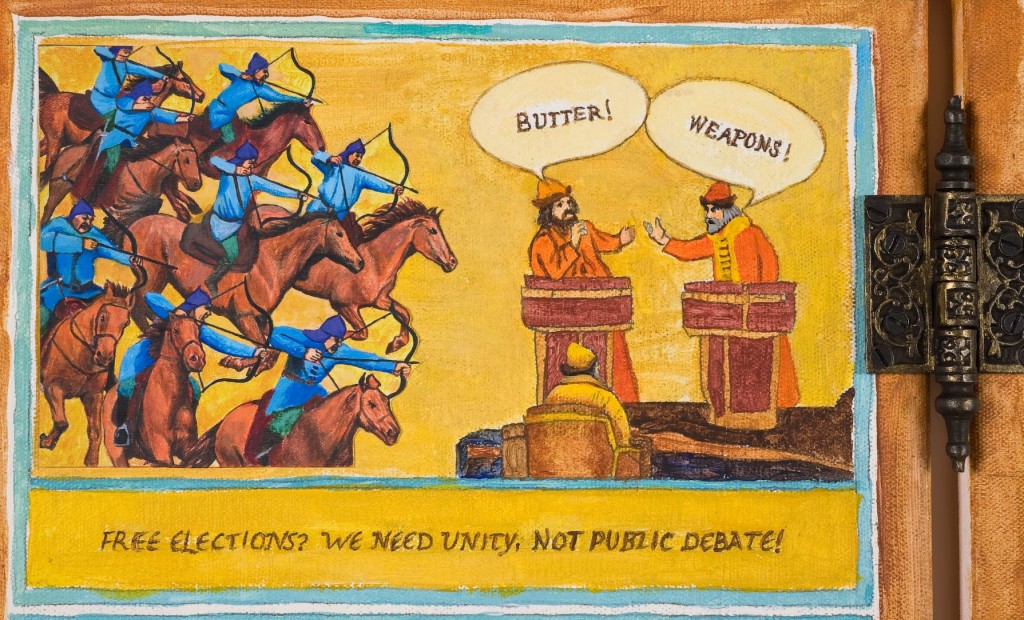
Detail of right panel of “Home Security At Any Crazy Price,” by Anne Bobroff-Haja
But what if the US had had repeated assaults every year since 2001, in which thousands of Americans were killed? And if yearly onslaughts continued indefinitely?
What if we lived in a land so vulnerable that we had a 9/11 every year for over five centuries?
Then what kind of government would we be willing to tolerate? One that abridged our personal freedoms constantly in order to keep us ever-mobilized and battle-ready? Would we accept our entire society being organized like a military hierarchy, with a single tsar at the top commanding us into position to survive our unending state of emergency?
What can our 9/11 experience help us fathom about Russia?
Few Americans are aware that Russia was born and forged in terror from outside its borders: constant devastation by enemies and the kidnapping into slavery of hundreds of thousands of Russians, from the 13th century till the 18th.

Detail: Right upper panel of “Home Security At Any Crazy Price,” by Anne Bobroff-Hajal
First, ferocious, brilliantly-skilled Mongol raiders pillaged, sacked, brutalized, and occupied Russia for a couple of hundred years. For centuries after that, the Mongols’ descendants, the Tatars, swept across Russia virtually every summer, abducting 5,000, 10,000, 20,000 or more people each year to sell in the Black Sea slave market, a straight shot across the steppes to the south.
In fact, our word “slave” derives from “Slav.” No population in the world other than Africans have been enslaved more than Slavs. (For more on the reasons, see “The Most Exposed Terrain on Earth.”)
In short, Muscovites were traumatized by terror, as were New Yorkers on 9/11. But Russians were terrorized again and again for hundreds of years.
Well, haven’t all countries been attacked throughout history?
Every country in history has been repeatedly attacked. Their people too have had to drop normal life to run inside inside the walls of their local castle for protection.
What was different about Russia was the frequency of assaults. Slave raids occurred not once in 10 or 25 years – but every year. Because these raids occurred every year, they earned the moniker “the harvesting of the steppe.” Every member of the Russian gentry was responsible for military duty at the frontier for one half of every single summer to protect the vast southern border against raids.
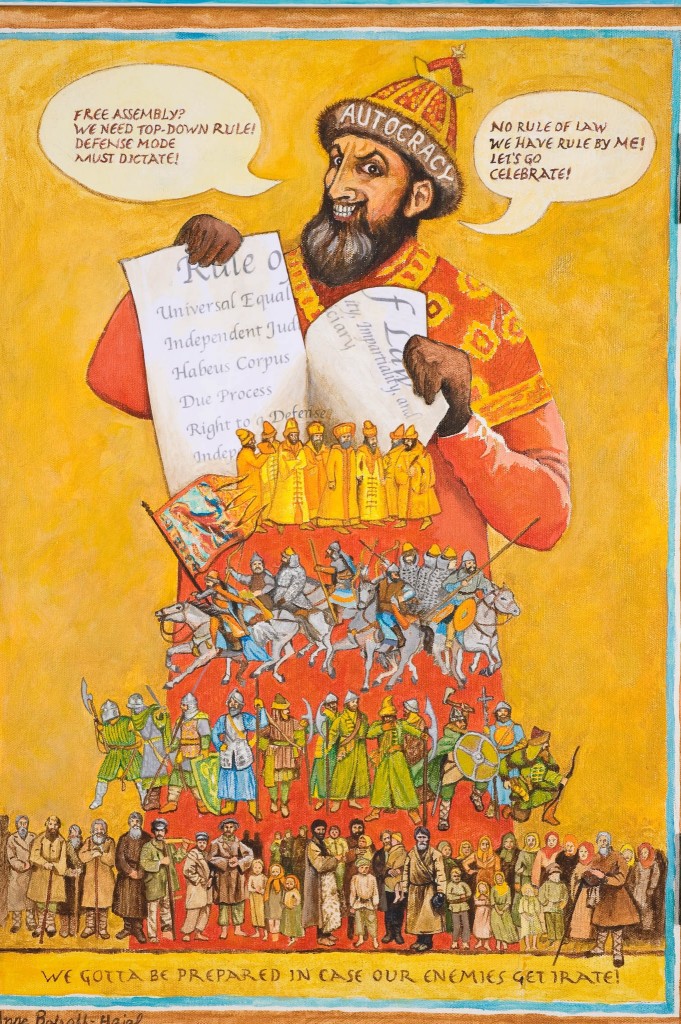
Detail of center panel from “Home Security At Any Crazy Price,” by Anne Bobroff-Hajal
The frequency of attacks on Russia was partly due to its lack of natural protective barriers along a longer open border with powerful enemies than anywhere else on earth.
The only geographic area comparable with Russia’s southern frontier might be the American Great Plains frontier (north/south orientation) in early US history. But next to the US frontier lay the remnants of native tribes nearly wiped out by disease spread from Europe to the New World. Next to the Russian frontier, in contrast, were large, flourishing, major powers of the day: the Crimean Khanate, the Ottoman Empire.
It would be as if the early United States had had the equivalent of both El Qaeda and Akhmedinezhad’s government living along its frontier.
Tsarist autocracy was military rule
The tsarist state was military hierarchy writ large (above). The entire society could never relax from war preparations and fighting. Centers of power independent of the tsar couldn’t develop because the military chain of command always had to be in effect society-wide.
Home Security At Any Crazy Price visualizes the impact on civil liberties of the unending threat of attack. Continued below image
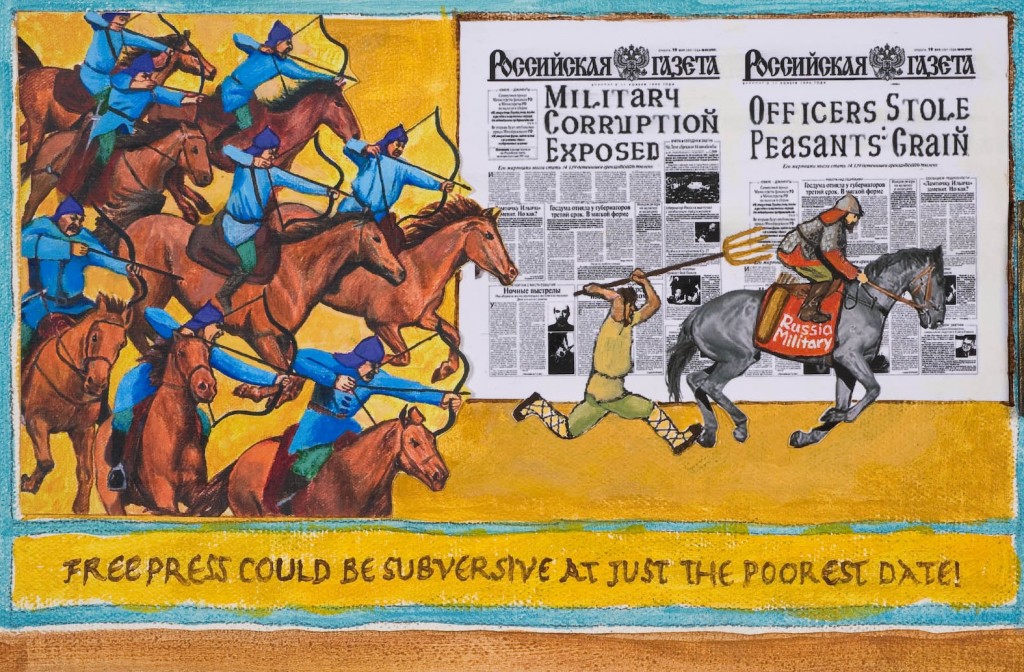
Detail of lower left panel of “Home Security At Any Crazy Price,” by Anne Bobroff-Hajal
Why didn’t civil liberties blossom after the slave raid threat ended in the late 18th century?
Institutions which have been forged over a period of five centuries don’t change overnight. New autocrats make use of earlier institutions – controlled press, secret police, patronage – to maintain and strengthen their power.
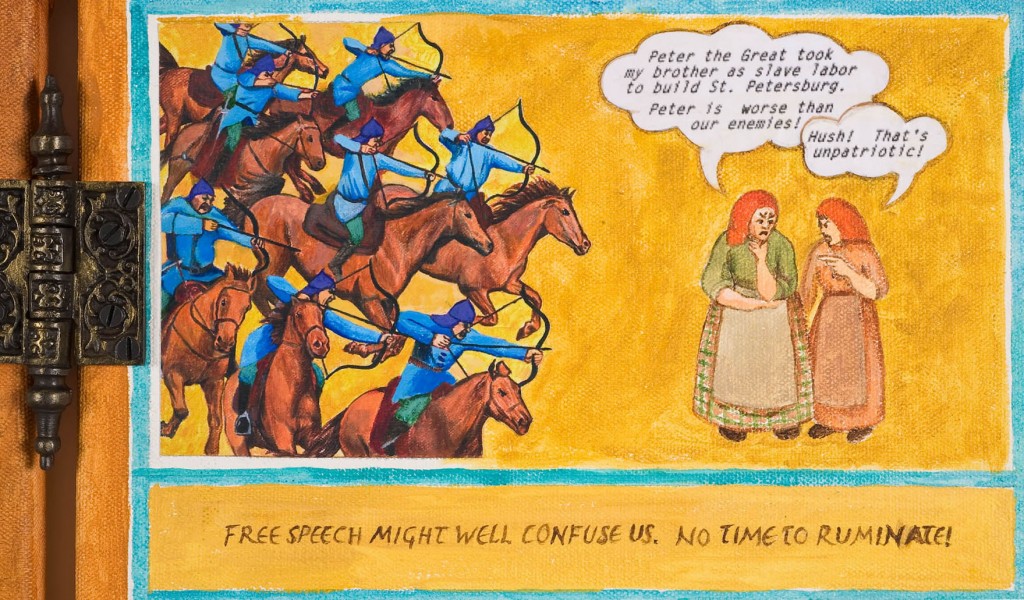
Detail of right panel of “Home Security At Any Crazy Price,” by Anne Bobroff-Hajal
Since the fall of Communism, Russia is again becoming more centralized. Putin has asserted control over the media. No non-Kremlin newspaper can garner significant circulation. Journalists who report stories the government doesn’t like are murdered. Real opposition political parties aren’t allowed to run candidates.
Will Russia ever become a fully pluralistic society? I don’t know, but I’m interested in watching to see. Continued below image
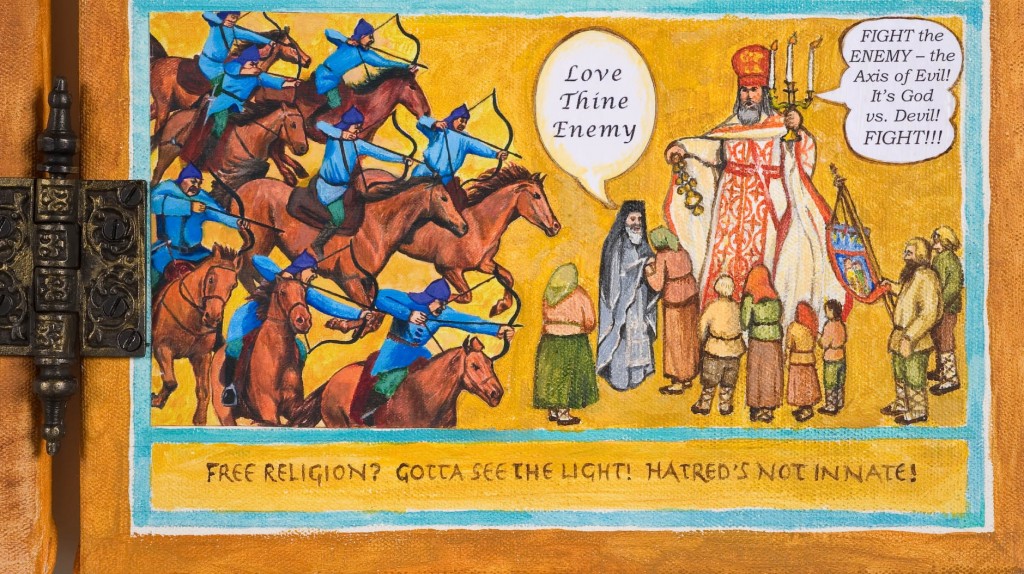
Detail of lower right panel, “Home Security At Any Crazy Price,” by Anne Bobroff-Hajal.
What can Russia and our own experience of 9/11 teach us about ourselves?
The US experience of terrorism on 9/11 can help us better grasp why Russia developed an autocratic state. A nation of people who experienced almost yearly trauma for centuries adapted to their society’s being permanently organized like a military chain of command with no insubordination from the ranks.
We can also learn from Russia’s experience the terrible consequences of sacrificing civil liberties for security over the long term. Russian history can serve as a cautionary tale for what could happen to us if we’re too ready to trade personal freedoms for powerful government. ■
Below image are links to more posts about PLAYGROUND OF THE AUTOCRATS triptychs.
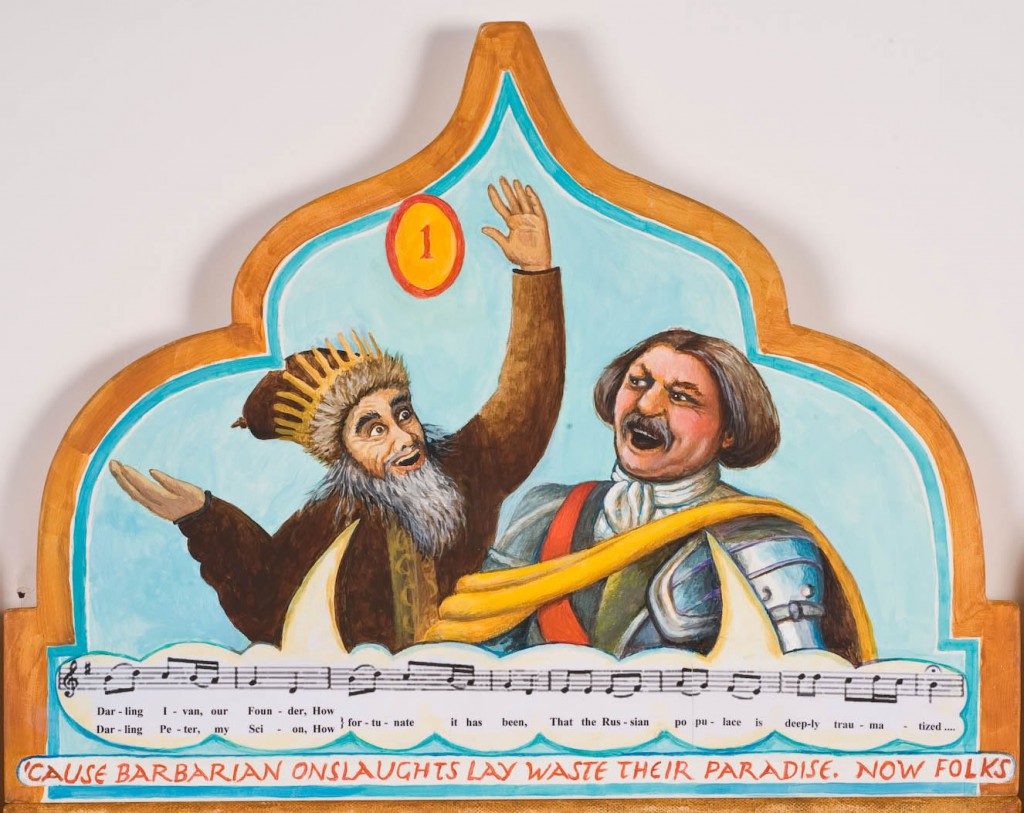
Detail: Top center panel of “Home Security At Any Crazy Price,” by Anne Bobroff-Hajal
An introduction to the PLAYGROUND OF THE AUTOCRATS series is here. Other posts about these triptychs are:
Portraying the Vast Flatland of the Playground
The Most Exposed Terrain On Earth
Designing the Character of Peter the Great
Catherine the Great: A Satirical Visualization of Russian History and Society
What is Catherine the Great Singing in Her Triptych?
How I Painted and Composited Catherine the Great (and Stalin)




















